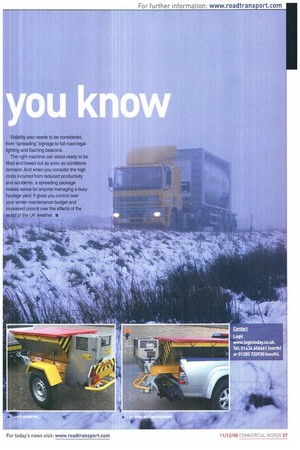With the possibility of wintry weather on the way, your
Page 56

Page 57

If you've noticed an error in this article please click here to report it so we can fix it.
vehicles aren't going to earn money if they can't even reach the road...
Words: Jamie Starr
Keeping the transport
yard running like clockwork is vital in today's world, where vehicle movements are so precisely timed, but there's always something happening that could disrupt the smooth flow of traffic into and out of the depot.
At this time of year, the most common bugbear is the weather, and while you may not be able to control what happens on the road network, at least you can control what happens in your own yard. It wouldn't be so bad if it were more predictable — the past few years have been comparatively mild — but ice and snow can quickly decimate your schedules. One ice-covered ramp can wreak havoc on a busy loading dock.
Tackling the effects of cold weather is a balancing act: effective salting/gritting is key, but winter maintenance budgets are under pressure. The solution has to be flexible, costeffective and reliable, as well as being available to deploy at a moment's notice.
Logic, based in Northumberland, has been making compact salt spreaders to tackle these circumstances for more than 10 years. These spreaders are towed, meaning any suitable vehicle (4x4, pickup. van, compact tractor) can be used to spread road salt efficiently at the first signs of a cold snap. Just like highway-sized machines, the salt spreaders benefit from a moving-floor hopper that delivers the salt to a spinning disc. Inside the hopper there is an agitation system that ensures the salt does not bridge, which is the major trouble with auger
and vibration systems. So even wet rock salt that has been standing for a while is usable.
The hopper has a sturdy mesh screen over the top to enable large lumps to be broken up during loading. Once through the mesh, the salt is managed by the agitation and delivery system so that it ends up where it needs to be: on the slippery surface. The application rate is adjustable by means of a sluice-gate. The system also allows salt to be cast to the left or right of the vehicle. Hopper capacities are 465 litres or 585 litres.
Meltdown
Dealing with ice can now be a one-man job, whether it is applying a precautionary amount of salt to ensure early mornings go without a hitch, or for fighting the worst the winter can throw at you. Salt is effective as a de-icer, as long as the temperature is not lower than -8°C. But it's rare for it to be any colder in the UK. When the temperature does drop, grit is used to provide grip for tyres (as in the US and Scandinavia, where temperatures are much lower for longer). But it's the use of salt in the UK that makes it key to make the correct purchasing decision.
Many of the US-made machines on the market have been designed as grit spreaders, rather than salt spreaders, and salt is highly corrosive. With that in mind, Logic machines come with either a two-pack corrosion-resistant paint finish or with stainless-steel hopper and peripheral components. Either way, they are built to
deal with UK conditions and will last for years as long as normal maintenance and care is used.
Spreaders are either ground-drive or selfpowered. Ground-drive machines can be specified with lowor high-range gearboxes, which give the machines spread widths of between 1.5m and 10m, or 3m and 14m at 15mph. As the disc is driven by the road wheel, road speed determines the spread width. The unit is towed to the site to be covered: the drive to the belt is engaged using a lever: and the unit is towed at the speed that gives the required spread width.
Logic's powered models use a 5.5hp Honda engine to drive the spreading mechanism. This allows suspension to be fitted to the axle, so the unit can be towed at • normal road speeds between jobs. The range also has a demount unit; this can be lifted into a pickup, wagon or flat-bed trailer using a forklift truck and secured, making any suitable vehicle into a salt-spreading asset. With the powered range, the disc speed is determined by the on-board engine. The drive belt can be switched between high and low ratios quickly, giving maximum flexibility where a variety of spread widths are needed.
Visibility also needs to be considered, from "spreading" signage to full road-legal lighting and flashing beacons.
The right machine can stand ready to be filled and towed out as soon as conditions demand. And when you consider the high costs incurred from reduced productivity and accidents, a spreading package makes sense for anyone managing a busy haulage yard. It gives you control over your winter maintenance budget and increased control over the effects of the worst of the UK weather. •




























































































































































